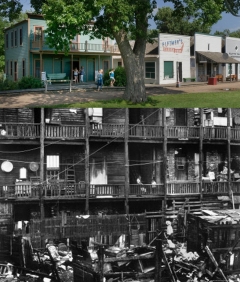 At no time in human history had so much changed in such a short time. In 1850 most people worked for themselves, mostly in rural villages; by the end of the century most worked at jobs in big cities. Concepts we take for granted today, like commuting and having a job, are not much more than 100 years old–a speck in the timeline of human existence.
At no time in human history had so much changed in such a short time. In 1850 most people worked for themselves, mostly in rural villages; by the end of the century most worked at jobs in big cities. Concepts we take for granted today, like commuting and having a job, are not much more than 100 years old–a speck in the timeline of human existence.
The Civil War provided the initial impetus as the Union army developed the strategy which would dominate multiple wars: outproduce the enemy. The end of the Civil War saw the rapid growth of railways and the industries supporting them: steel, locomotives, train cars, etc. The industrial revolution also brought dramatic growth in things much more mundane, like sewing machines, stoves and bicycles. Oh, and Durant’s carts and buggies.
All was not ice cream and apple pie, however. One percenters like John D. Rockefeller and George Pullman considered it their right to demand longer hours for lower pay from workers. And because Big Money controlled the political machine that’s what they got. And so America entered an age of dramatically increased prosperity, but a prosperity not shared equally by all.
The egregious abuse of labor for the outsize gain of the few led to the rise of organized labor. Unrest and violence, even death became commonplace as workers struggled to obtain some semblance of fairness. Not ice cream and apple pie.
Gilded Age, The Book
The glaring disparity in wealth distribution inspired Mark Twain to pen his book The Gilded Age in 1873. As sometimes happens, the book was soon forgotten but the name stuck: gilded means a thin veneer of gold over something cheap like wood. America, everyone saw, was not in the golden age some portrayed. Mass breadline poverty overlaid with a thin crust of ultra-wealthy families created merely a gilded age.
The gilded age also witnessed the growth of trusts, the word of the day for monopolies. At the time the normal view was once you’ve established a successful business, the next step was to absorb the competition like Rockefeller and Morgan did. Limit competition and restrict entry into your market, that’s how you grew rich and influenced politicians. The trusts controlled Wall Street: who got money and went without.
Billy, too, aspired to riches untold by going to New York and learning to play the games rich people played. A millionaire from his successful horse drawn cart business, he could buy his way into the best clubs and his ingratiating personality helped him make good friends. However, his Midwestern roots couldn’t get him into the inner sanctum of Wall Street. J.P. Morgan, the high priest of American wealth, simply refused to believe anybody that successful so quickly could sustain it: Billy had to be a charlatan. Morgan refused to believe in Billy’s merit as a businessman, and by extension the industry he represented. Automobiles, Morgan staunchly believed until his death, were nothing more than another whim which would pass as surely as the bicycle fad did.
Business in the Gilded Age
Despite the horror stories, the facts show more people made more money in their jobs than they did working for themselves. The stoves, sewing machines, carts and, yes, automobiles, were bought by a new class of people who had that newfangled thing: disposable income. And a generation of entrepreneurs arose to invent, manufacture and market products unthinkable a few years earlier. Radios, telephones, bicycles, sewing machines, stoves, the list of new inventions is endless.
Many of these entrepreneurs came from other industries. The Wright brothers went from bicycles to airplanes, for example. David Buick jumping from bathtubs, and Billy from from carts, to automobiles therefore was not that unusual.
Not all businesses treated their workers harshly. Billy’s cart and automobile businesses never had a strike during his and Dallas Dort’s tenure. Dort implemented a health coverage scheme for workers long before others thought of it.
Billy’s success was in no small part due to him living in the gilded age. His products came on the market at a time when sufficient numbers were able to afford them and upgrade their lives.